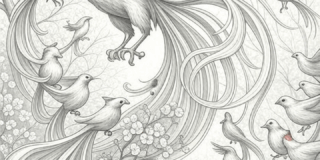My approach to life owes much to Lao Tzu’s maximum: “Live life in all possible ways; don’t choose one thing against the other, and don’t try to be in the middle.”
Not being in the middle is the starting point of my song.
Why a song, I hear you ask – because songs don’t wait to resolve, because songs mean so much. Stories wait for endings; songs are brave things bold enough to sing when the story of life is still unfolding. My song, like most songs, will be written next to midnight, between hope and fear, as both claim to save us.
Thus begins my song. This song and the life it represents are both things of contrast – pain and hope, regret and possibility. As always, to lend a hand with my song I call on my chorus a chorus of Mimi’s.
While strictly speaking Mimi’s are not part of Wiradjuri culture, my association with these mischievous creatures goes back to my childhood when my foster father and I made a pilgrimage north, to Arnhem Land which I wrote about in a previous post.
Only when man’s life comes to its end in prosperity can one call that man happy – Aeschylus Agamemnon I 928
One of the first things I learned in life is not to take it for granted, but to make the most of opportunities as they present and to become the best person I can.
Shortly after my first birthday I was removed from the care of my father, a Wiradjuri man, and made a ward of the State – I was lucky in my placement, as many weren’t. When I was old enough to realise the significance of what had happened I resolved to become the best person that I can – a resolution measured not in materialism but in understanding.
It’s not midnight yet, my song goes on. We all screw up, we generally try hard. The balance of whether or not we have done our best in life is weighed at life’s end. It’s not an absolute thing – it’s a measure counterbalanced against the measure of when we simply gave up on what really mattered (after all, the other stuff is just foam – full of air with no real substance and therefore holding no weigh)
Rock-art the domain of the Mimi is true passion. Aborigines believe in a cultural landscape where the land and its people are interdependent, where everything has meaning and purpose. It is an external landscape as well as an ‘inscape’, the spirit, or soul that makes an object more than is perceived by our ocular senses. The landscape then becomes both physical and metaphysical, that which we can feel and see and the inner soul of the land, that which is past, future and contemporary.
Suzi Gablik on visiting Australia in 1980 recorded the following description of her response to the landscape:
“It was only when I touched the country – which hangs back aloof and unapproachable just beyond the cities – and encountered a landscape so fierce and primaevally strange that it frightened D H Lawrence and I felt in the presence of something uniquely Australian, a stored power that our civilization has so far not managed to obliterate…”
Gablik here is saying that to the unobservant and non-engaged spectator, Australia may present a vast and generally featureless expanse, demarcated only by variations in climate where individuals can seem insignificant against the backdrop of this landscape. On looking closer though one can see the long and complex history of Aboriginal Australia preserved in the myths and Dreamtime stories that permeate this landscape. All we have to do is open our hearts to the land empathetically and the land of its own free will allows us to know it. In knowing, we are engaging with the land and its history.
Many years ago I commenced a pilgrimage to the great centers of rock art scattered over this giant boulder we call Earth. This trip eventually took me to Bamyan via Kabul, where I met a particularly gifted story teller in Chicken Street in the Afghani capital. The story teller painted a vision in words where the larger of the two Bodhisattva‘s became an ancient devil, a torment to the soul of all good Muslims. While my historical knowledge of the Bodhisattva‘s told me otherwise, the story become part of the legend of the Bamyan Bodhisattva.
The Bodhisattva‘s themselves are, or were, epic poetry expressed in the visual medium of sculpture, a physical landmark and a repository of sacred spiritual knowledge available to all with the wisdom to interpret their symbolism. When I finally reached the Bodhisattva and journeyed to their ‘inscape’ the story recounted by the story teller of Chicken Street had become part of the story of the lives of this Bodhisattva. Unfortunately for the rest of humanity Sheik Omar of the Taliban held the same views as the story teller and had the Bodhisattva‘s destroyed – though I’m sure their soul remains.
To not engage with the land, is to miss all that has travelled before and to forgo the opportunity to step beyond ourselves and embrace humanity in all its facets.
I was recently privileged to experience a Wangga, a genre of song and dance performed by the men of Wadeye of the Walakandha people which highlighted to me the uniqueness and originality of Indigenous Australian art.
To fully appreciate these concepts it’s necessary to be present at a ceremony, to hear the songman chanting and tapping his sticks or boomerangs, setting the tempo and rhythm. Hear the didjeridoo or drone-pipe player in diapason tone giving depth and breadth to the rhythm, a base for the superstructure of song and stick-taps, of the accented exclamations, hisses, “breathings”, shouts and stamping of the dancers. See the ballet, with stamping in time with the songman, arms and bodies expressing the theme of the chant in perfect time and representative movement. There indeed is the true chorus, bystanders included, clapping their hands or cupping their thighs to the beats. If it is not a men’s secret ceremony women may be seen on the edge of the dance-ground, bodies swaying, feet moving up and down, in and out, but always in the one place, their hands playing a string game, perhaps without string. All taking part are painted and adorned with patterns belonging to their various ceremonial groups symbolising their totems. Often the didjeridoo and tapping boomerangs may be painted. Secret rites also usually include painted or engraved symbolic objects of wood, stone or composite constitution which are used as a means of directing thoughts to the Dreamings, each pattern designed for a specific soul.
In the ritual dance we see the embodiment of the sacred art of Aboriginal Australia with its ballet, singing and poetry (for the chants are often poems of no mean order), as well as the visual arts of painting, engraving, moulding, carving or sculpture. They are part of the symbolic Dreamtime, ensuring eternal life to nature and man. They are part of the mystic world, representing on the material plane conceptions of this mystic world of shades and Dreamings, the virtue of which is expressed through symbol and sacrament. This ballet with its connection to the art of the escarpment may yet bring the Mimis back to reclaim their footprints.
Some interesting discussions which will stay with me always, were had on indigenous art, with a past associate Jonathan Doy over the years.


